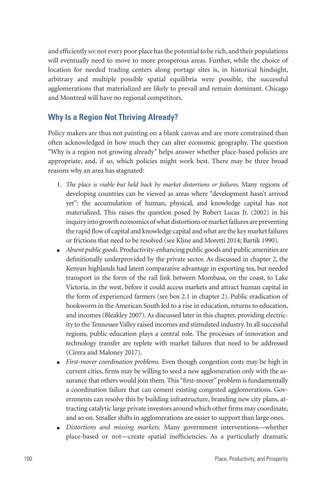and efficiently so: not every poor place has the potential to be rich, and their populations will eventually need to move to more prosperous areas. Further, while the choice of location for needed trading centers along portage sites is, in historical hindsight, arbitrary and multiple possible spatial equilibria were possible, the successful agglomerations that materialized are likely to prevail and remain dominant. Chicago and Montreal will have no regional competitors.
Why Is a Region Not Thriving Already? Policy makers are thus not painting on a blank canvas and are more constrained than often acknowledged in how much they can alter economic geography. The question “Why is a region not growing already” helps answer whether place-based policies are appropriate, and, if so, which policies might work best. There may be three broad reasons why an area has stagnated: 1. The place is viable but held back by market distortions or failures. Many regions of
■
■
■
100
developing countries can be viewed as areas where “development hasn’t arrived yet”: the accumulation of human, physical, and knowledge capital has not materialized. This raises the question posed by Robert Lucas Jr. (2002) in his inquiry into growth economics of what distortions or market failures are preventing the rapid flow of capital and knowledge capital and what are the key market failures or frictions that need to be resolved (see Kline and Moretti 2014; Bartik 1990). Absent public goods. Productivity-enhancing public goods and public amenities are definitionally underprovided by the private sector. As discussed in chapter 2, the Kenyan highlands had latent comparative advantage in exporting tea, but needed transport in the form of the rail link between Mombasa, on the coast, to Lake Victoria, in the west, before it could access markets and attract human capital in the form of experienced farmers (see box 2.1 in chapter 2). Public eradication of hookworm in the American South led to a rise in education, returns to education, and incomes (Bleakley 2007). As discussed later in this chapter, providing electricity to the Tennessee Valley raised incomes and stimulated industry. In all successful regions, public education plays a central role. The processes of innovation and technology transfer are replete with market failures that need to be addressed (Cirera and Maloney 2017). First-mover coordination problems. Even though congestion costs may be high in current cities, firms may be willing to seed a new agglomeration only with the assurance that others would join them. This “first-mover” problem is fundamentally a coordination failure that can cement existing congested agglomerations. Governments can resolve this by building infrastructure, branding new city plans, attracting catalytic large private investors around which other firms may coordinate, and so on. Smaller shifts in agglomerations are easier to support than large ones. Distortions and missing markets. Many government interventions—whether place-based or not—create spatial inefficiencies. As a particularly dramatic Place, Productivity, and Prosperity

